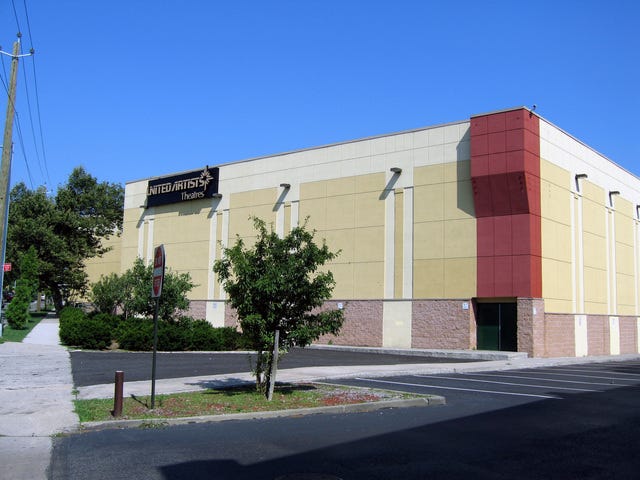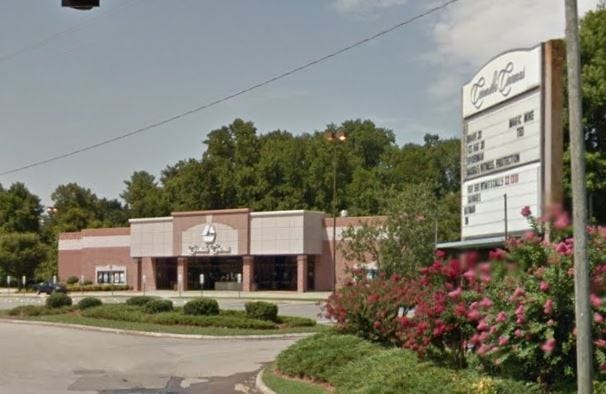
Objectively speaking, my present-day movie-going experience is better than it ever has been. When I want to see a movie, I hop on the F train and ride it up a few stops to the Nitehawk Cinema, an independent movie theater with an eclectic programming style that offers full-service dining and drinks. I love going to the Nitehawk, and I will never turn my back on a theater that allows me to get drunk and eat tater tots while I’m watching a movie, but I’d be lying if I didn’t acknowledge that something is missing. It’s not quite right to say the entire experience is “too good,” but it’s honestly not far off.
You see, as a teen growing up in the suburbs of Winston-Salem, North Carolina, all of my most cherished moviegoing experiences took place in chain theaters of widely varying quality. They carried with them all the distinct pleasures of a chain theater: ugly red carpets, expensive concessions, unreliable customer experience, and massive lobbies stocked with out-of-date arcade games. Of particular import to me was the Carmike 10. It was a full 30 minute drive from my house, in an inexplicably swampy corner of town. The Carmike was the sort of theater where a lot of the seats didn’t work and mysterious holes would appear in the vast parking lot and stay there, unfilled, for decades. It got stadium seating years after the other theaters in town did, and there was really no reason to ever go out there, unless you were trying to sneak into an R-rated movie like Hostel and wanted to maximize your odds of success.

The Carmike in Winston-Salem was nothing special, but because it was so generic and unmemorable, it was the perfect backdrop for dozens of pivotal (and not-so–pivotal) moments in my teenage years. For a lot of people, the mall serves a similar purpose. When you’re young, the specific stores inside your local mall don’t really matter – the important thing is that it’s a place where you can get away from your parents, hang out with your friends, and engage in low-stakes mischief. I love watching movies and I’m happy to do it pretty much anywhere, but when I go to a big-name chain theater, I feel a deep spiritual connection that is enhanced by the architecture around me… which I suppose makes it less like a mall and more like a church.
There are some theaters in New York that have come close to recapturing this experience (such as The Kent Theater in Midwood), but I have never found a true equivalent in the city… until the day that I first ventured to the very edge of South Brooklyn and entered the lovely little theater known by the charmingly awkward sobriquet, Regal UA Sheepshead Bay.
Originally opened in 1987 by United Artist Theaters under the equally-cumbersome name “The Movies at Sheepshead Bay”, this Regal stands proudly on the shore of Shell Bank Creek. When approaching the Regal, the eyes of a first-time visitor might be drawn across the water to the docks and houses that dominate the small neighborhood of Gerritsen Beach. Or you might instead be surprised by the wooden statue of a fisherman that looms tall among the weeds and rubbish at the end of a small street. To the statue’s immediate right, one sees a Cold Stone Creamery, a TGI Fridays, and between the two of them, an abandoned building with a blue awning under which is hung a sign reading “Coming Soon: BROOKLYN LOBSTER & CRAWFISH.” We should be so lucky.
This collection of eateries, directly across from the theater, contribute greatly to the Sheepshead Bay Regal’s atmosphere of suburbia in miniature, but equally important is the amount of parking lot on display – which is to say, a lot. The TGI Friday’s and Cold Stone each have their own little parking lots, while the Regal offers a small parking lot supplemented by a three-level parking deck. Since the Regal is located in Brooklyn, there’s no chance of recreating the sprawling parking lots of my beloved North Carolina cinemas, but the effect is similar enough, and it’s enhanced by the fact that I’ve never seen enough cars there to fill even the first level.

The general emptiness adds to an pleasant ambiance of light desolation that pervades the entire theater. It is enhanced by the fact that, despite being a fully-operational fourteen-screen multiplex with RPX and IMAX, the Regal in Sheepshead Bay only appears to have six employees. One of these, usually an elderly man, is always stationed at the entrance to the lobby to take your ticket. Another one is floating around nearby, ready to sell tickets to people who can’t deal with the kiosks out front. There’s usually another employee lurking somewhere in the depths of the building, carrying a single broom and dust-pan that somehow manages to keep every theater clean – I genuinely don’t understand how they do it.
The concession stand is the place where you can usually find the largest number of staff members congregating, and while the service is always polite and efficient, one should not be too adventurous in their ordering. If one, theoretically speaking, wanted to order a Coors Light to drink while watching The Nun II at 3:40pm on a Friday, or a hot dog to eat during a Sunday afternoon screening of Saw X, be warned that you will endure a Kafkaesque ordeal of confusion and humiliation. Stick to popcorn, candy, and soda. Don’t get fancy with it.
Then there’s the location. Traveling to the Regal in Sheepshead Bay, much like traveling to the Carmike 10, feels like walking up to the edge of the earth in one of those old-timey maps that have dragons swimming around in the ocean. I take no pleasure in reporting this, because as a resident of Parkville – Brooklyn’s finest neighborhood, which my many haters will surely decry as ‘fake’ – I too have faced South Brooklyn Erasure from people who have never been below Prospect Park and think that Fort Greene is ‘downtown.’ But I’ve spent the last decade of my life in between Church Ave and Kings Highway, and in my mental geography, Belt Parkway is a liminal space that offers passageway to JFK International Airport – and, by the way, when you get onto that AirTram platform and look out over Jamaica Bay, you will truly feel like you have reached the edge of civilization.
But the life of the mind and the world outside of it are two very different things. In reality, Sheepshead Bay is a vibrant community that began as a secluded fishing and farming village before the development of Manhattan Beach across the bay in the late 1800s. Manhattan Beach was transformed into a popular resort spot almost entirely through the efforts of a single anti-Semitic railroad tycoon and soon enough, visitors found that those locals fishing in Sheepshead Bay were really onto something.
The same year that the aforementioned robber baron opened his second hotel in Manhattan Beach, the Sheepshead Bay Race Track opened, offering a convenient location for people to lose hundreds of dollars betting on horses, which I’m assuming was a lot of money back then. The racetrack was sold in 1913, after the Hart-Agnew bill effectively banned gambling in New York State, and the new owners used it for automobile racing. It closed permanently in 1919, which is really a shame, because I think we can all agree that Brooklyn would only stand to rise in national regard if there was a NASCAR track right off Avenue X.
As the nearby Coney Island became a popular tourist destination in its own right, Sheepshead Bay became less and less of a draw, gradually shifting into a sleepier residential neighborhood that nonetheless held within its borders some of the finest dining establishments that Brooklyn has ever known. The best example of this is Lundy’s, a seafood restaurant whose rise, fall, second rise and final fall is a story cycle deserving of more attention that I can reasonably give it here. I was born after Lundy’s first closure and didn’t move to the city until 6 years after its second (and greatly diminished) incarnation shut its doors, so it is for me forever consigned to the realm of history. But there is a place in Sheepshead Bay – a magical, wonderful place – where the neighborhood’s history of culinary excellence is alive and well. That place is Roll-N-Roaster.
Roll-N-Roaster opened in 1970, a fact confirmed by the sign above the cashier thanking you for 53 years of business and also by every other piece of décor in the restaurant. Roll-N-Roaster belongs to that ever-shrinking class of restaurants where you can still clearly tell where the smoking section was. Everything, from the logo to the uniforms to the walls themselves, is orange, brown, or somewhere in between. The inspiration for the design of the building itself seems to be “Wendy’s sunroom chic” – you know that old joke about making the entire airplane out of the black box material? Roll-N-Roaster is like that, but for Wendy’s sunrooms.
Really, no description can do it justice, you should just look at some pictures – and while you’re at it, please take a look at the menu. I saw this years before I ever went to Roll-N-Roaster and was struck not only by the variety of food on offer – roast beef, fried shrimp, and “the best thin-crust pizza in NYC?” – but by the menu’s greatest price outlier, the bottle of Moet champagne. I didn’t exactly think this was a joke, per say, but I found it so ridiculous that I was shocked to walk into Roll-N-Roaster the first time and discover that, no, they really do sell Moet – it’s in the glass case right up front, next to slices of cake and bottles of $3 beer.
All of Roll-N-Roaster is like that. You look up at the Spin-N-Win wheel hanging above the cash register, and you think, “How funny, it must have been a real hoot to see them spin that back in the day,” but then you find out that, no, if you show them an ID proving that it’s your birthday, they will get out a long hook, reach up and give that motherfucker a spin. You can get a discount of up to $25, and let me tell you, $25 goes a lot further at Roll-N-Roaster than it does almost anywhere else. That thing about $3 beers was not a joke.
But the greatest thing about Roll-N-Roaster is that it’s a five-minute drive from the Regal. It’s a perfect place to go after a movie, whether you want to discuss what you’ve just seen with your friends or sit in solitary contemplation as you watch the constant thrum of people. In these moments of quiet reverie, one is made aware not only of the vast array of human experience contained within the borough of Brooklyn, but of one’s own place in it. I am not immune to the pleasures of suburbia, but only in New York City have I ever found this sort of peace.
As for the Carmike 10, it was eventually absorbed by AMC and rebranded as the AMC Classic Winston-Salem 10 before ultimately closing in 2020. After that, it was transformed into a place that could never match the spiritual significance of its original incarnation: a non-denominational evangelical church. Towards the people who attend this church, I bear no ill will — the true blame lies upon all of the real estate moguls and MLM scammers responsible for this demonic perversion of a once-holy place. And if I catch any of them out in the world, you’d better believe it’s on sight.



